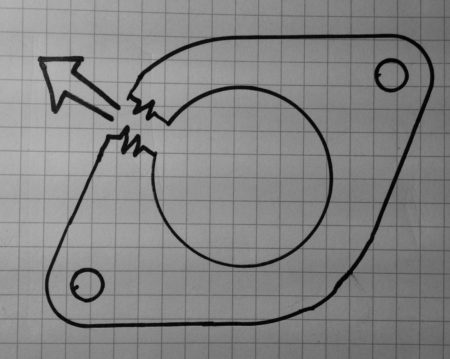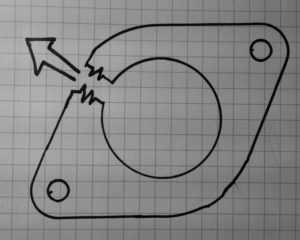 The fall guy…defined by the Urban Dictionary as “a person who is left with the blame for a crime, regardless of whether they were involved or not”. In our world, the fall guy is the lowly gasket. Too many times, gaskets tend to be an afterthought in the design process, BUT the gasket (or the material) is the first to be blamed if there are ever any problems in the application. If you are currently designing (or may ever design) an application that has gasketed joints, or are currently in the middle of troubleshooting (or may ever troubleshoot) because of a leak in a joint, this week’s post is for you!
The fall guy…defined by the Urban Dictionary as “a person who is left with the blame for a crime, regardless of whether they were involved or not”. In our world, the fall guy is the lowly gasket. Too many times, gaskets tend to be an afterthought in the design process, BUT the gasket (or the material) is the first to be blamed if there are ever any problems in the application. If you are currently designing (or may ever design) an application that has gasketed joints, or are currently in the middle of troubleshooting (or may ever troubleshoot) because of a leak in a joint, this week’s post is for you!
Over the years, we have just about seen it all. We’ve been a part of varying stages of design projects….at times we’ve almost been a part of the design team, lending our expertise to help ensure success once the gasket is cut, and other times we come in at the tail end to suggest a material that will meet your exact specifications. We’ve also been the firefighters…driving in on our big red truck with hoses spraying (ok, not really…) to offer a gasket material solution when everything else you’ve tried isn’t working. Blame it on the design of the joint, blame it on the design of the gasket, blame it on the material, blame it on the rain….regardless, there are potential problems lurking everywhere and we’re here to help you navigate some of those issues. Everyone’s time (and money) is valuable and we want you to be educated and aware of what can be done to minimize your chances of a gasket blowout.
What You Need To Know
Protecting your product launch and the application from the damage a gasket blowout can cause is your #1 priority in design (or redesign). Nobody wants a gasket to be the reason a project can’t launch as planned. Like we mentioned above, your gasket may be the culprit, but the issue might also be something else entirely. Here are 7 things to consider to help protect your application from gasket blowouts.
1. Material choice
Designers must use caution to select a material that is suited for the operating conditions, including temperature, pressure, fluid resistance, durability (for handling), durability (in service), aging characteristics, and other factors.
2. Temperature
Consider the peak exposure, and choose material capable of withstanding that level of exposure.
3. Pressure
Sealing joints that are holding back high pressure need to have a gasket with reinforcement to provide radial strength. Be sure to choose reinforced material for high pressure joints.
4. Flange loading
Flanges are critical pieces of the bolted joint. Consideration must be given to: flange flatness, surface finish, stiffness, material (expansion), preparation, and others.
5. Assembly
Joints must be assembled properly to recommended torque values and sequence. Often with compressible products, a second round of final torque once operating temperature has been achieved is also helpful to maintain load over long-term service.
6. Protection
Some gaskets exposed to extreme conditions can benefit by additional protection which shields the gasket body from destructive conditions. Heat flow, fluid erosion, and other “wear effects” can be protected against by flange rings, embossments, coatings, and other protective measures.
7. Thickness
Generally speaking, the thinnest gasket you can use is the best choice. Thickness gets increased to compensate for flange conditions or other factors. Thinner gaskets have less chance for blowout than thick ones since the load is concentrated over less volume, providing higher shear strength to prevent blowout.
Go Forth
We love a good gasket blowout picture – send us yours, and we just might feature it in an upcoming article. If you are interested in subscribing to Sealed-In’s blog posts, email sales@mtigasket.com.

The fall guy…defined by the Urban Dictionary as “a person who is left with the blame for a crime, regardless of whether they were involved or not”. In our world, the fall guy is the lowly gasket. Too many times, gaskets tend to be an afterthought in the design process, BUT the gasket (or the material) is the first to be blamed if there are ever any problems in the application. If you are currently designing (or may ever design) an application that has gasketed joints, or are currently in the middle of troubleshooting (or may ever troubleshoot) because of a leak in a joint, this week’s post is for you!
Over the years, we have just about seen it all. We’ve been a part of varying stages of design projects….at times we’ve almost been a part of the design team, lending our expertise to help ensure success once the gasket is cut, and other times we come in at the tail end to suggest a material that will meet your exact specifications. We’ve also been the firefighters…driving in on our big red truck with hoses spraying (ok, not really…) to offer a gasket material solution when everything else you’ve tried isn’t working. Blame it on the design of the joint, blame it on the design of the gasket, blame it on the material, blame it on the rain….regardless, there are potential problems lurking everywhere and we’re here to help you navigate some of those issues. Everyone’s time (and money) is valuable and we want you to be educated and aware of what can be done to minimize your chances of a gasket blowout.
What You Need To Know
Protecting your product launch and the application from the damage a gasket blowout can cause is your #1 priority in design (or redesign). Nobody wants a gasket to be the reason a project can’t launch as planned. Like we mentioned above, your gasket may be the culprit, but the issue might also be something else entirely. Here are 7 things to consider to help protect your application from gasket blowouts.
1. Material choice
Designers must use caution to select a material that is suited for the operating conditions, including temperature, pressure, fluid resistance, durability (for handling), durability (in service), aging characteristics, and other factors.
2. Temperature
Consider the peak exposure, and choose material capable of withstanding that level of exposure.
3. Pressure
Sealing joints that are holding back high pressure need to have a gasket with reinforcement to provide radial strength. Be sure to choose reinforced material for high pressure joints.
4. Flange loading
Flanges are critical pieces of the bolted joint. Consideration must be given to: flange flatness, surface finish, stiffness, material (expansion), preparation, and others.
5. Assembly
Joints must be assembled properly to recommended torque values and sequence. Often with compressible products, a second round of final torque once operating temperature has been achieved is also helpful to maintain load over long-term service.
6. Protection
Some gaskets exposed to extreme conditions can benefit by additional protection which shields the gasket body from destructive conditions. Heat flow, fluid erosion, and other “wear effects” can be protected against by flange rings, embossments, coatings, and other protective measures.
7. Thickness
Generally speaking, the thinnest gasket you can use is the best choice. Thickness gets increased to compensate for flange conditions or other factors. Thinner gaskets have less chance for blowout than thick ones since the load is concentrated over less volume, providing higher shear strength to prevent blowout.
Go Forth
We love a good gasket blowout picture – send us yours, and we just might feature it in an upcoming article. If you are interested in subscribing to Sealed-In’s blog posts, email sales@mtigasket.com.

The fall guy…defined by the Urban Dictionary as “a person who is left with the blame for a crime, regardless of whether they were involved or not”. In our world, the fall guy is the lowly gasket. Too many times, gaskets tend to be an afterthought in the design process, BUT the gasket (or the material) is the first to be blamed if there are ever any problems in the application. If you are currently designing (or may ever design) an application that has gasketed joints, or are currently in the middle of troubleshooting (or may ever troubleshoot) because of a leak in a joint, this week’s post is for you!
Over the years, we have just about seen it all. We’ve been a part of varying stages of design projects….at times we’ve almost been a part of the design team, lending our expertise to help ensure success once the gasket is cut, and other times we come in at the tail end to suggest a material that will meet your exact specifications. We’ve also been the firefighters…driving in on our big red truck with hoses spraying (ok, not really…) to offer a gasket material solution when everything else you’ve tried isn’t working. Blame it on the design of the joint, blame it on the design of the gasket, blame it on the material, blame it on the rain….regardless, there are potential problems lurking everywhere and we’re here to help you navigate some of those issues. Everyone’s time (and money) is valuable and we want you to be educated and aware of what can be done to minimize your chances of a gasket blowout.
What You Need To Know
Protecting your product launch and the application from the damage a gasket blowout can cause is your #1 priority in design (or redesign). Nobody wants a gasket to be the reason a project can’t launch as planned. Like we mentioned above, your gasket may be the culprit, but the issue might also be something else entirely. Here are 7 things to consider to help protect your application from gasket blowouts.
1. Material choice
Designers must use caution to select a material that is suited for the operating conditions, including temperature, pressure, fluid resistance, durability (for handling), durability (in service), aging characteristics, and other factors.
2. Temperature
Consider the peak exposure, and choose material capable of withstanding that level of exposure.
3. Pressure
Sealing joints that are holding back high pressure need to have a gasket with reinforcement to provide radial strength. Be sure to choose reinforced material for high pressure joints.
4. Flange loading
Flanges are critical pieces of the bolted joint. Consideration must be given to: flange flatness, surface finish, stiffness, material (expansion), preparation, and others.
5. Assembly
Joints must be assembled properly to recommended torque values and sequence. Often with compressible products, a second round of final torque once operating temperature has been achieved is also helpful to maintain load over long-term service.
6. Protection
Some gaskets exposed to extreme conditions can benefit by additional protection which shields the gasket body from destructive conditions. Heat flow, fluid erosion, and other “wear effects” can be protected against by flange rings, embossments, coatings, and other protective measures.
7. Thickness
Generally speaking, the thinnest gasket you can use is the best choice. Thickness gets increased to compensate for flange conditions or other factors. Thinner gaskets have less chance for blowout than thick ones since the load is concentrated over less volume, providing higher shear strength to prevent blowout.
Go Forth
We love a good gasket blowout picture – send us yours, and we just might feature it in an upcoming article. If you are interested in subscribing to Sealed-In’s blog posts, email sales@mtigasket.com.
